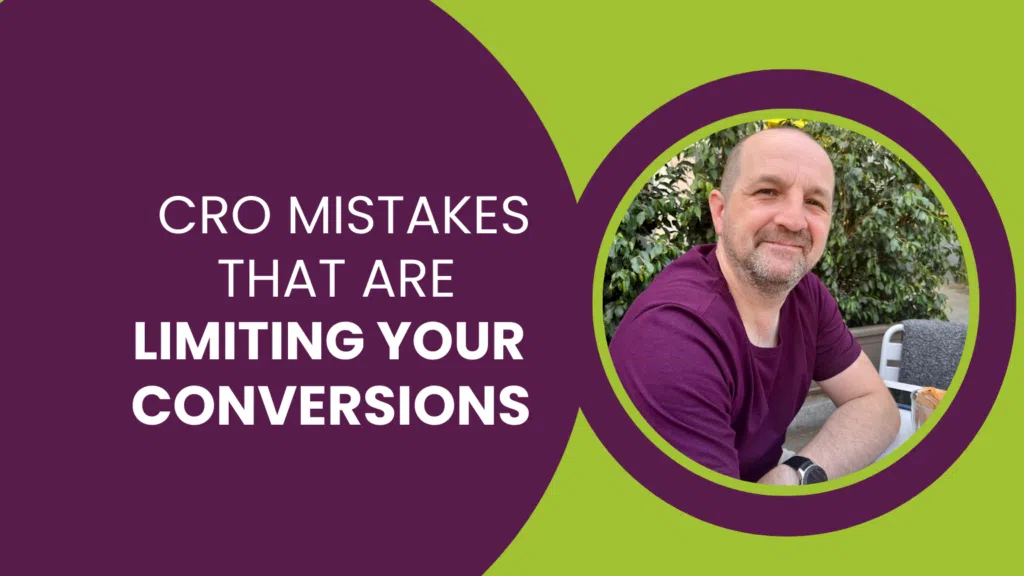In this blog, we delve into the intricacies of CRO, offering invaluable insights to marketers and business owners alike. Join us as we uncover the critical missteps to avoid, empowering you to optimise your website’s performance effectively. Let’s embark on this journey together towards achieving unparalleled success in the realm of digital marketing.
Neglecting to Prioritise Page Speed Optimisation
Undoubtedly, the swiftness of a website is crucial for user experience. Slow-loading websites often result in frustration for users, leading to increased bounce rates and diminished engagement. Despite this awareness, many website owners tend to overlook the significance of optimising page speed.
The reluctance to embark on site speed optimisation projects stems from their perceived complexity and potential costs. Addressing issues related to page speed may entail substantial modifications to website infrastructure and functionality, which can be daunting for site owners.
Yet, it’s imperative to recognise the profound impact of page speed on user behavior and conversion rates. Even minor delays in page loading times can significantly deter visitors from engaging with your content and completing desired actions. Hence, neglecting page speed optimsiation can prove detrimental to overall website performance and business objectives.
You don’t have a clear call to action
When optimising your website conversion rate, there’s more to creating a call to action than placing a link or button on a landing page. Your content should provide readers with encouragement to read on and potentially convert, while also avoiding being too pushy or sales-oriented, then your call to action button should close the deal by being easy to find and compelling.
Your content should:
- Focus on benefits, not features
- Restate the messaging in any ads or other content that led the reader to the page
- Create a sense of urgency
- Establish trust
- Increase the value proposition
You don’t have compelling headlines
Using ‘power words‘, making your headlines short enough that they aren’t cut off in search engine result, using numbers in your headlines… All of this advice is true. You’ve probably read it in a dozen other places. What’s missing is something simple – your headline has to communicate that your post is going to share something of value. That’s what will get people to click on your links, read your content and hopefully improve your website conversion rate.
In addition to thinking about your headline, you must also put thought into your subheadings as well. Keep in mind that a lot of your readers will skim before reading, and compelling subheadings will help convince them that all of your content is worth reading. Use words and phrases in your subheadings that make readers want to learn more.
It’s also a good idea to relate your subheadings to your title in some way, as this provides readers with a continuity. For example, if your headline is in the form of an open-ended question, you could write your subheadings similarly. If it’s appropriate for your audience and topic, don’t be afraid to use humour to make your headings and subheadings more engaging – just avoid tired wordplay and overused ‘jokes’.

Your copywriting and language usage is poor
It’s a difficult thing to do, but you have to take a very honest look at your writing skills. If they are poor, your content isn’t going to increase your website conversion rate.
Poor writing with multiple errors is often seen as a red flag and it can make your web pages seem as if they were put together in a hurry. People will also associate a lack of care in your writing with a lack of care in your products and services. To be blunt, poorly written web content can cause people to think your business is low quality at best and, at worst, a scam.
However, poorly written content isn’t an indicator that you don’t know your products, or that you don’t have business expertise. People struggle with writing for a variety of reasons – you may be writing in a language that isn’t your first, or you might simply be better at communicating verbally.
Whatever the case may be, optimising your website conversion rate depends on your ability to publish quality content. Fortunately, there are a host of services available to help – these include Grammar.com, SupremeDissertations, Hemingway, RewardedEssays, and GetGoodGrade. These resources offer advice on writing and can help with editing, proofreading, copywriting, outsourcing and grammar checking. If you have particularly urgent content requirements, you might consider a service such as EssaySupply, which comes highly recommended by clients who have used it for copywriting work that required a quick turnaround time.
You post contains misleading information
If someone sent fact checkers from Snopes to verify your content, how would you do? Would they determine your content as true, false, or a mix of both? Snopes may not verify your content, but you can be sure others will.
Namely your potential customers and competitors are going to check the veracity of your claims. If your proof is lacking, or you get caught making exaggerated claims, that can really mean trouble for your website conversion rate. Word spreads quickly, and people aren’t very forgiving about this kind of thing. This is especially true if your claims are intended to paint competitors in a bad light, or entice customers to spend their hard-earned money.
The best way to avoid this issue altogether is to prioritise integrity in your content. It’s perfectly fine to emphasise the positives about your company, and to be a bit bold about calling out the competition – just avoid making claims that don’t quite pass the sniff test.
Better yet, don’t give readers an excuse to ‘verify’ your claims. Instead, do that work for them – add links to authoritative sites, post data and case studies that prove your claims, or add trust elements to your website or blog such as testimonials and trust badges. By doing these things, you will increase trust and thought leadership.
Your buyer personas use too many stereotypes
In marketing, we create buyer personas – these are, in a sense, character sketches of the people we think would be interested in whatever it is that we are selling. They are often based on data that is used to predict specific needs and interests based on demographic information.
Personas are infinitely useful for website conversion rate optimisation, but they can also come dangerously close to stereotypes. That can be problematic when it comes to your content – people want content that speaks to them, not a stereotype of them.
Here are a few tips to avoid speaking to stereotypes and caricatures in your content:
- Don’t be lazy – avoid clichés about millennials, baby boomers etc
- Dig deeper when you create your personas
- Learn as much as you can about your actual customers
- Examine your customer engagement and learn from it
Your content lacks a clear structure
Nobody likes repetitive, cookie-cutter content but, in contrast to that, some predictability can help. This is why many content creators use structured content.
Basically, structured content creates a framework upon which you write your content. It doesn’t stop you from writing on multiple topics, nor does it prevent you from creating content that is humorous or creative either.
Structured content accomplishes the following:
- Makes it easy to post full and summarised content to specific target audiences
- Streamlines the process of using content on multiple platforms
- Makes it easier for readers to understand content and pull out the information that is relevant to them
- Makes content maintenance noticeably easier
Most importantly, by employing structured content, you make the quality assurance (or QA) process exceptionally easier. Imagine having a template to follow as you double check to ensure that blog posts and landing pages have all of the elements that they need.
Finally, if you use translations services, employing structured content can simplify that process. According to Pauline Farris of translation service provider IsAccurate: “When we translate large batches of content, the predictability of structured content allows us to work quickly. In addition to this, when content must also be localised, having structured content helps us ensure that each version is complete and accurate.”

You’re engaging in keyword abuse
Most of us know that keyword stuffing ruins content. We also know that it’s a quick way to get on the bad side of Google and other search engines. Unfortunately, it’s common enough to warrant mentioning.
Not only that, if you tend to be a bit repetitive in your writing, you may be keyword stuffing without realising it. Pay attention to your writing, especially where you mention your brand, products or services. Are you using the same adverbs and adjectives?
For example, imagine that you own a cleaning company – naturally you might use the phrase ‘house cleaning’ in your content. That’s expected, but if you use the phrase ‘cheap house cleaning’ over and over that could be problematic. Change up your keywords and if you are unsure if you are using too many keywords, stick to a keyword density of around 2%. You can calculate this by dividing the number of keywords in your copy by the total number of words.
There are other forms of keyword abuse as well, such as:
- Using grammatically incorrect keywords in an attempt to match every keyword combination that users may search
- Publishing multiple pages of content on the same keyword
- Using irrelevant keywords
- Failing to use long-tail keywords
- Not using keywords in your tags and headings
- Failing to do keyword research, missing out on important keywords and using outdated keywords
Ethan Dunwill, Content Editor at HotEssayService, has this advice on using keywords: “The best way to avoid the appearance of keyword abuse is to simply focus on content value. Give readers relevant content that they can apply to their lives first and foremost. Then, strategically add keywords to help ensure that search engines will guide them to that content.”
Conclusion
The content you share with your audience can drive your website conversion rate, or it can drive people away. To accomplish the former, you must start with well-written content which is relevant to your audience. It should be truthful and backed by data. Draw readers to your content with the intelligent use of keywords, and headlines that make them want to read more. Finally, consider adding a bit of predictability to the format of your content so that readers know exactly how to find what they need.
FAQS
Is Conversion Rate Optimisation event worth it?
Conversion Rate Optimisation (CRO) is absolutely worth it for businesses looking to maximise their online presence and increase profitability. Here are several reasons why:
Increased Revenue: By optimising conversion rates, businesses can turn more of their website visitors into customers. Even a small increase in conversion rates can result in significant revenue growth.
Better User Experience: CRO often involves improving the user experience on a website, which can lead to higher customer satisfaction and loyalty. A smooth, intuitive website encourages visitors to stay longer and makes them more likely to convert.
Data-Driven Decisions: CRO relies on data analysis to identify areas of improvement on a website. This data-driven approach ensures that changes are based on solid evidence rather than guesswork, leading to more effective optimisations.
What is the most important thing to consider across conversion rate optimisation?
The most important thing to consider across conversion rate optimisation (CRO) is understanding your target audience. Here’s why:
Relevance: Knowing your audience helps ensure that your website, content, and offerings are relevant to them. When visitors feel that your site addresses their needs and interests, they’re more likely to engage and convert.
User Experience: Understanding your audience allows you to tailor the user experience to their preferences. This includes elements like navigation, design, and messaging, which can significantly impact conversion rates.
Messaging and Value Proposition: By knowing your audience’s pain points, desires, and motivations, you can craft compelling messaging and value propositions that resonate with them. This increases the likelihood of visitors taking desired actions
Does SEO increase conversion rate?
Yes, SEO (Search Engine Optimisation) can have a significant impact on increasing conversion rates. By optimizing your website for search engines, you improve its visibility and ranking in search results, which can lead to increased organic traffic. When your website ranks higher in search engine results pages (SERPs), it becomes more accessible to potential customers who are actively searching for products or services related to your business.
What is the difference between conversion rate optimisation and SEO?
Conversion Rate Optimisation (CRO) and Search Engine Optimisation (SEO) have distinct roles but work together for online success.
CRO aims to boost the number of website visitors who complete specific actions, like making purchases or signing up for newsletters. It involves tweaking different website elements to encourage conversions.
Meanwhile, SEO focuses on improving a website’s visibility and ranking on search engine results pages (SERPs). It revolves around optimising content, meta tags, and site structure to attract more organic traffic from search engines.
While CRO concentrates on enhancing user experience and conversion paths within a site, SEO aims to drive traffic and visibility from search engines. Both strategies share the goal of enhancing online performance and business growth. Integrating effective CRO and SEO strategies offers a comprehensive approach to online marketing, resulting in increased conversion rates and organic traffic.







